| Columns Retired Columns & Blogs |
Why do so many Hi-Fi brands forgo balanced connections? This unit is $4000. Many amps have an input sensitivity >2V, so you’d thus have to deal with lower wattage or use an active preamp.
I measured the Ideon Ayazi mk2 with my Audio Precision SYS2722 system. I performed the testing using the Ayazi's coaxial S/PDIF input, which accepted data sampled at all rates up to 192kHz, and its USB port. I repeated some of the tests feeding data to the 3R Master Time Black Star's USB port, the data then passed to the Ayazi's USB port. Apple's AudioMIDI utility revealed that the Ayazi's and Black Star's USB ports accepted 16- and 24-bit integer data sampled at all rates from 44.1kHz to 384kHz. Apple's USB Prober app identified both the Ideon products as "AYAZI True HD Audio\000" from "IDEON-AUDIO\000," with the vendor ID as "C-MEDIA ELECTRONICS INC." (C-Media Electronics is a Taiwanese computer hardware manufacturer.) The USB ports operated in the optimal isochronous asynchronous mode.
The Ideon's analog output preserved absolute polarity (ie, was noninverting), and the output level with full-scale 1kHz data was 1.975V, a negligible 0.11dB lower than the specified 2V. The output impedance was a low 234 ohms at 20Hz and 1kHz, 230 ohms at 20kHz.
The Ayazi's impulse response with 44.1kHz PCM data (fig.1) indicates that the reconstruction filter is a conventional linear-phase type, with symmetrical ringing before and after the single full-scale sample. With white noise sampled at 44.1kHz, the filter rolled off quickly above the audioband (fig.2, magenta and red traces), reaching full stop-band attenuation at 24kHz. The aliased image at 25kHz of a full-scale tone at 19.1kHz (cyan, blue) was therefore suppressed by more than 100dB. The harmonics associated with the 19.1kHz tone are all low in level, with the second harmonic the highest at just –80dB (0.01%).
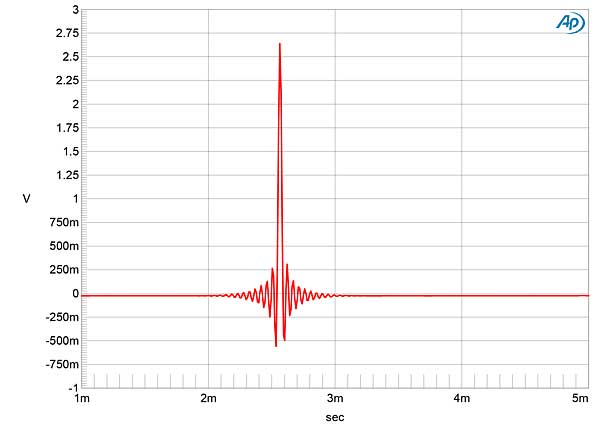
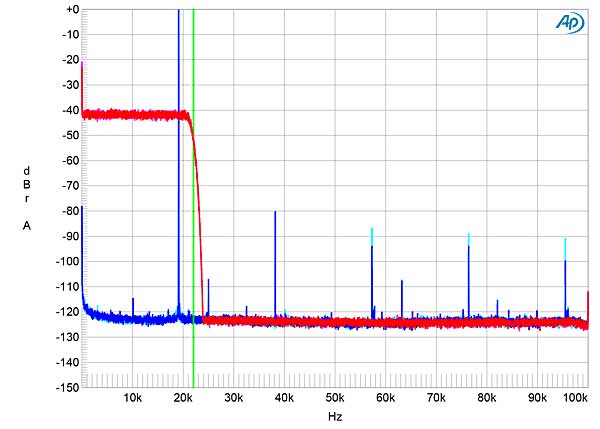
Fig.3 shows the Ideon's frequency response with S/PDIF data sampled at 44.1, 96, and 192kHz. The responses at all three sample rates follow the same basic shape: flat in the audioband with then a sharp rolloff just below half of each rate. Below 3kHz, channel separation (not shown) was excellent, at 99dB, R–L, and 108dB, R–L. It decreased to a still-excellent 94dB in both directions at the top of the audioband. The low-frequency noisefloor (fig.4) showed a power supply–related tone at 60Hz, but this was very low in level, at –110dB (0.0003%). The blue and red traces in this graph were taken with USB data. With S/ PDIF data (green and gray traces), there was a slight rise in the noisefloor close to the fundamental tone. The spectrum with USB data fed to the Black Star clock and then to the Ayazi was identical to the blue and red traces in fig.4.
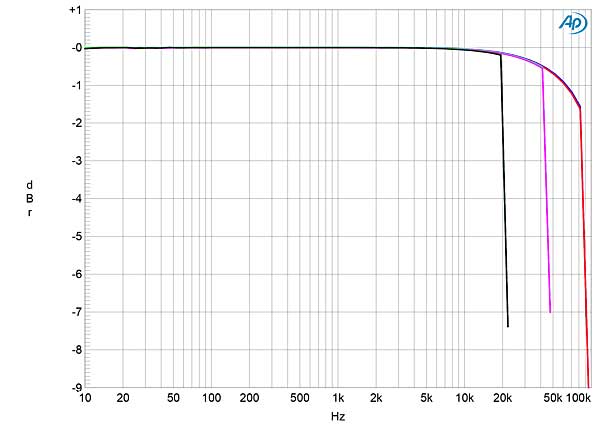
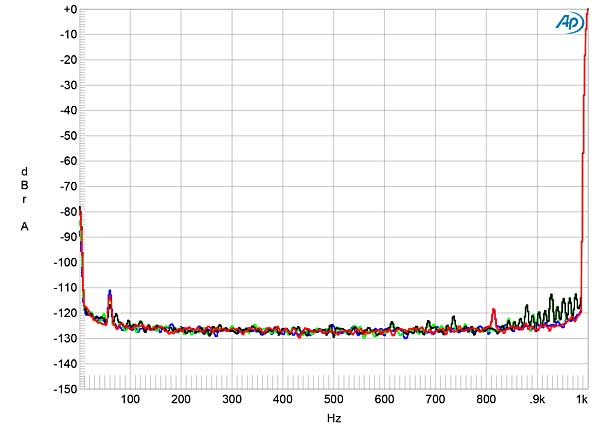
The Ayazi's linearity error with 24-bit data (not shown) was negligible until the signal lay below –120dBFS, which implies high resolution. An increase in bit depth from 16 to 24 with dithered data representing a 1kHz tone at –90dBFS (fig.5) dropped the Ayazi's noisefloor by 13dB, which suggests that the DAC's resolution is around 18 bits. The presence of the third, fifth, and seventh harmonics with 24-bit data (blue and red traces) suggests that the least-significant bit is being truncated. Repeating the spectral analysis with USB data with and without the external clock gave an identical result. When I played undithered data representing a tone at exactly –90.31dBFS, the three DC voltage levels were well-resolved (fig.6), though the symmetrical waveform was overlaid with high-frequency random noise.

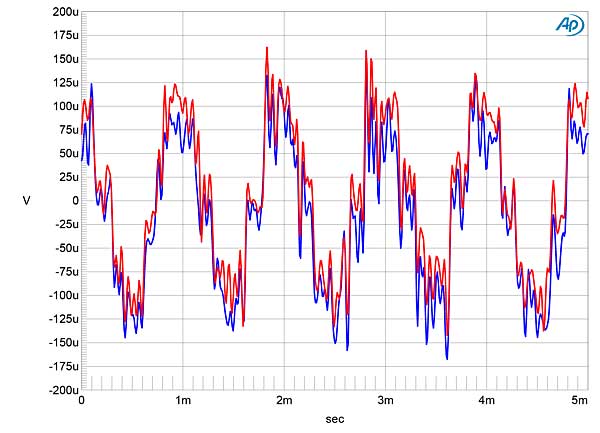
Driving high impedances, the Ayazi produced very low levels of harmonic distortion. With a full-scale 50Hz tone, the second harmonic was the highest in level in the right channel, at just –90dB (0.003%, fig.7). The third harmonic lay at –94dB (0.002%) in both channels. With the Ideon DAC driving the punishing 600 ohm load, the distortion increased dramatically (not shown), unless I reduced the signal level by 6dB. The Ayazi should not be used with preamplifiers that have an input impedance below 1k ohms. Intermodulation distortion with an equal mix of 19 and 20kHz tones, each lying at –6dBFS and sampled at 44.1kHz, was very low in level into high impedances (fig.8).
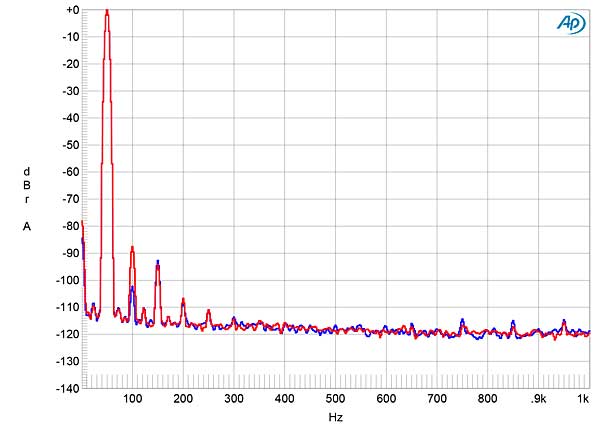
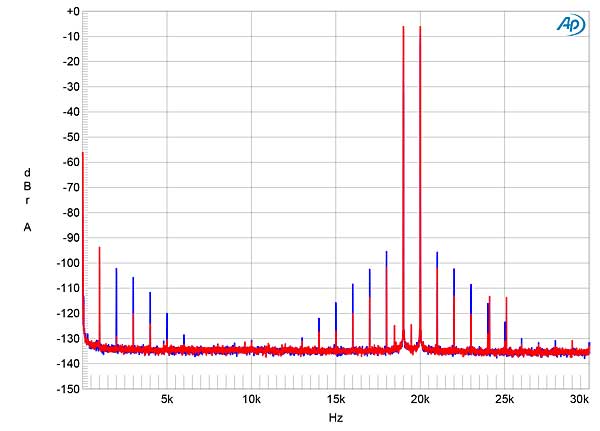
Fig.9 shows the spectrum of the Ayazi's output when it was fed high-level, 16-bit J-Test data via S/PDIF. The odd-order harmonics of the undithered low-frequency, LSB-level squarewave lie at the correct levels, indicated by the sloping green line, though a trio of low-level spurious tones is present between 8kHz and 10kHz. These tones disappeared when I repeated the analysis with 16-bit J-Test data sourced via USB (fig.10), though a pair of low-level sidebands at ±120Hz was now present. I ran the test again with a wire connecting the Ayazi's ground to the analyzer's chassis ground; the sidebands were still present, as they were when I performed the spectral analysis by feeding USB data to the external Black Star clock then to the Ayazi.
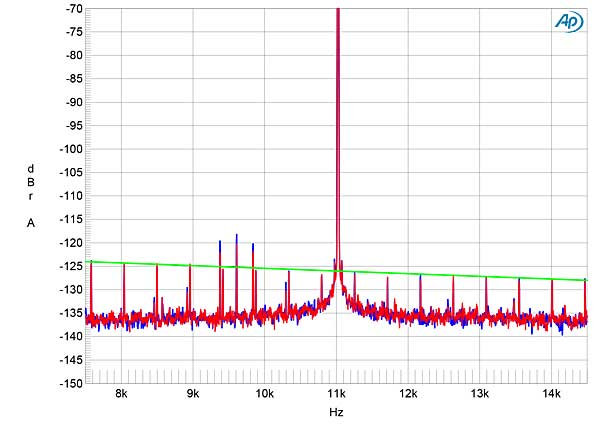
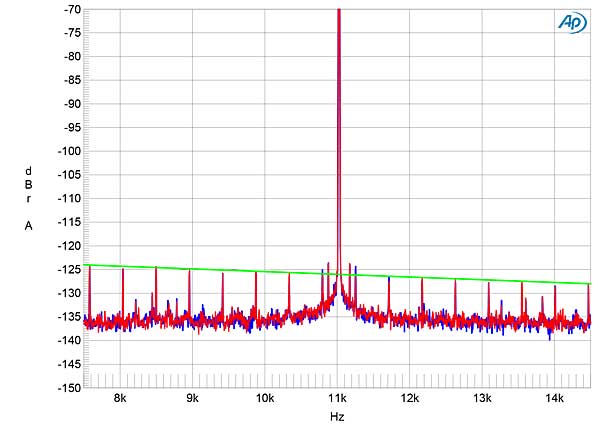
Overall, Ideon's Ayazi did well on the test bench. I didn't find any difference in its performance when fed USB data directly or via the 3R Master Time Black Star.—John Atkinson

I for one, can't understand usage of balanced lines.
Balanced lines, separate neutral and ground wires are required in instances where there is great distance between mikes for example and pre inputs, as in stagework and large recording studios.
As you mention at homes, average source signal levels are as high as 2Vs and average distance between source and other components are usually less than 0.5 m.
There shouldn't any use for balanced lines or connections at home. Yet they are often used on high priced equipment to give the illusion of high-end.
On the other hand, phono cartridges could benefit as their outputs are extremely low and susceptible to picking up hum.This is the only component in home audio where balanced lines could really help. Yet this fact is easily ignored by the high end crowd.

I’m not talking about balanced for increase performance, I’m talking about balanced as it 2x the output, 4Vrms being standard.
If this unit put out 4Vrms via RCA, I’d have no complaints. But it doesn’t, which leads to a smaller pool of amplifiers that can be paired with it without limiting the wattage.
Do note that even 4Vrms isn’t enough sometimes; the Purifi amp for instance, if you forgo any input buffer (for max performance), it requires something along the lines of 11Vrms!

Hi
Why single out Purifi classD amp's "abnormal" input sensitivity 11Vrms vs standard 2Vrms used by most most, if not all, brandname power amps ???
Like it or not, you demand tooooo much for unbalanced RCA jack output level which has been the standard since day one decades back.
Besides, not many audio guys like Class D sound. Not me for sure!
Purifi even offers optional "Amp Connector Board" to boost its "abnormal" low sensitivity 11Vrms to 1.5Vrms for full ouput power !!
Listening to analoge is believing
Jack L

I’m not demanding >2Vrms from the RCA outs.
But, if they don’t offer balanced (standard is 2x so 4Vrms), then the amp options are narrowed.
There is no excuse to not adding balanced output for any stereo DAC >$1000.

I’m not demanding >2Vrms from the RCA outs. But even a Denon surround sound receiver (X6700 specifically) can output > 4Vrms from it’s RCA outputs without clipping (clipping starts close to 4.5Vrms).
But, if they don’t offer balanced (standard is 2x so 4Vrms), then the amp options are narrowed.
Some amps have XLR only inputs. The excuse could be then to go buy an RCA->XLR cable, or your source could just already have XLR outputs.

Hi
Bingo. I can't agree more.
The primary functioin of balanced audio transmsssion/connection is to eliminate RFI noise airborne/ground noises into the audio signals passing thru the cables/interconnects.
Historically, paired balanced equal impedance line transmission was used for long long distanced telephone landline voice transmission, since day one decades back. It is to cancel out any common mode RFI noise at the receiving end of the transmission. So that the voice calls are still clear & noise-free hundred miles away.
Balanced equal impedance line connections for audio are commonly used in recording studios, auditoriums & outdoor audio PA functions where miles of audio cables are involved
That said, some long established recording studios still retend single-ended unbalanced cable systems.
For home audio where audio cables/interconnects are toooo short relative to professinal audios, to worry about RFI noises problem.
Yes, you hit the bullseye by pointing out "they are often on high priced equipment to give the ILLUSION of high-end."
Technically, balanced input/output can be provided effeciently & cheaply by using operation amplifiers (Op-amp) IC chips. Op-amps always come with normal & inverted (differential) inputs - balanced inputs. Such op-amp chips cost dirt cheap for a few buck a piece.
Marketing for higher price ! 'Hi-tech' balanced differential inputs along with conventinal unbalanced RCA jacks !!!
As a die-hard analogue guy, I would not touch any audio amps with op-amps in the signal path, balanced or what not. My skeptical ears can't take any IC chip sound, sorry.
Listening to analogue is believing
Jack L

MZKM: "Many amps have an input sensitivity >2V, so you’d thus have to deal with lower wattage or use an active preamp."
Yes, it's so easy to have far higher output gain from sources today with volume control and go direct without any negatives. (And as a bonus also have less distortion/colouration, than having an active preamp and another set of interconnects in line)
These manufacturers that refuse to give it, probably also sell active preamps, or have a buddy that does.
Cheers George

Hi
Yes, for better sound, for sure.
But the problem is not many programme sources with balanced outputs also come with level control, e.g. DAC, CD/DVD players.
So how can they be hooked up DIRECT to power amps with balanced inputs only, e.g. Benchmark power amps.
Don't worry. There are already PASSIVE balanced control boxes come with quality Japanese-made 4-gang volume control, available dirt dirt cheap from Amazon. Virtually a balanced signal straight-line passage with volume control.
Better sound & money saving for sure, than any active preamps for balanced signal volume control. This is physics.
As I said above, balanced audio is a sales gimmick for home audio.
No need for me technically & sonically (op-amp sound !!!).
Listening to discrete analogue is believing.
Jack L

Streaming a song costs the same amount of power as (buying and) downloading it once. Streaming (and data sharing in general such as on social media, the internet is one of the biggest polluters), eating meat, traveling and having a fireplace and bbq is not the future

Based on what I read here, you seem to have a limited experience with a DAC. Sure, you may have a ton of experience just not written here, but what I am picking up personally from your review is that you are not a DAC fanatic and you may not have an experience with other more established DACs around its price point. The question is - why is your review worth anything? Are you a professional reviewer knowing in and out of a DAC and its industry? Or, is your review just as good as any personal review on Amazon? You may be the former, but I'm leaning toward the latter.

All I care about is wether they know what to talk about. I don’t care if the person doesn’t even like music, as long as they are able to hear subtle changes and able to identify the changes occurred that resulted in that change (maybe the volume control is analog which has a large channel imbalance, altering the imaging/soundstage as the volume control is changed).

For me, I do not care if a $20,000 DAC sounds heavenly when it actually sounds similar to a $2,000 DAC. I read 3 DAC reviews from Alex. Every time, I cannot stop thinking 'no.. I don't think he knows a DAC. He does not sound like a DAC guy'. There are many products that sound wonderful. But, when a reviewer recommends a product, he must know how it compares to the competition. I have no idea who Alex is. Maybe he is/used to be a musician. Perhaps he can dive into the music deeper than most. But, say a grammy winning musician goes to an audio shop and listens to a DAC and loves it to death - it does not matter if he only heard 3 DACs in his lifetime. I personally find that's not much different from a five-year-old finding the next greatest toy of all time every time he steps into the target.